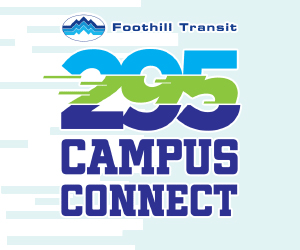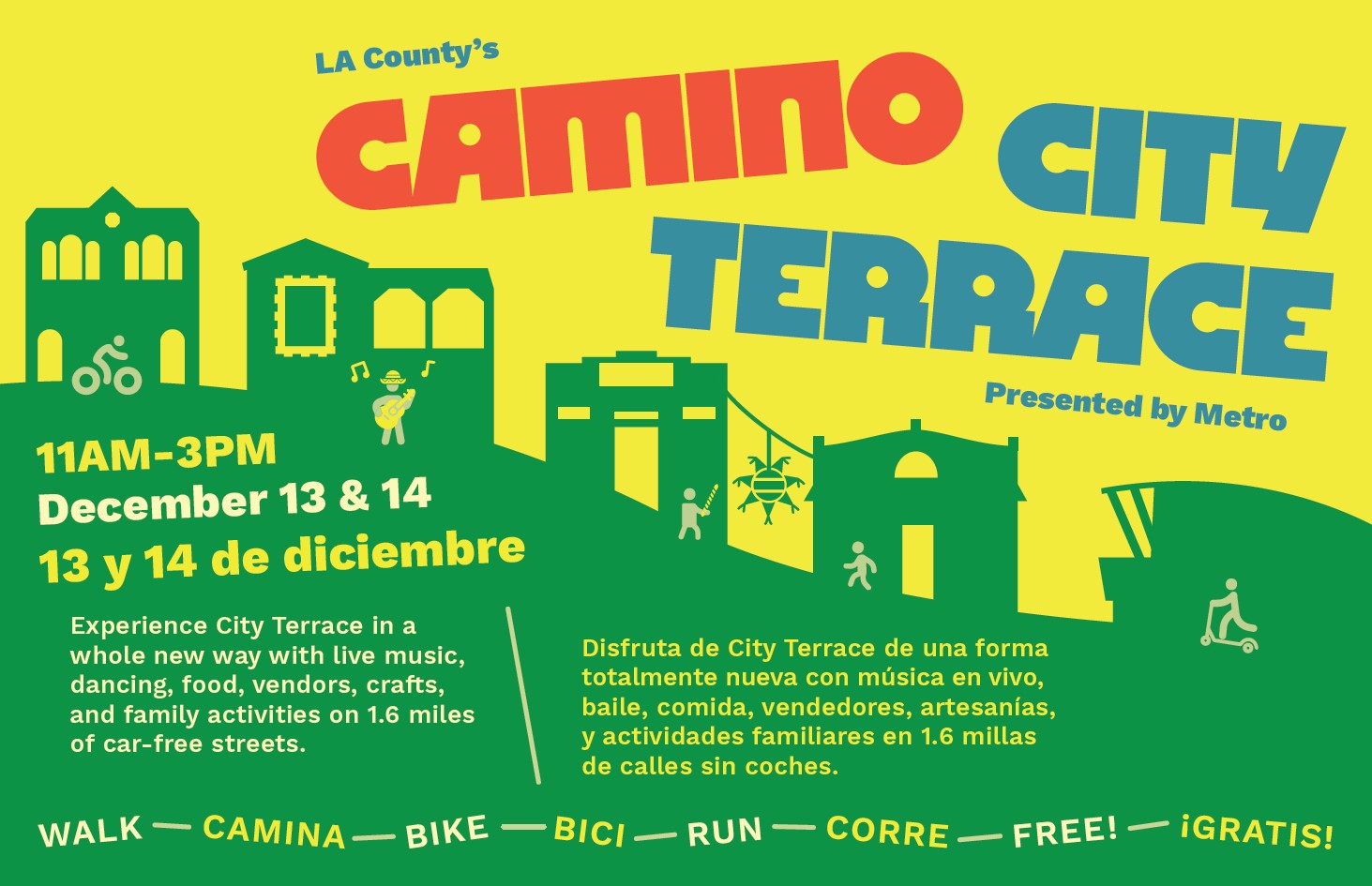In the last half-dozen years, the city of Pomona has stepped up efforts toward safer, more multimodal streets. As new light rail arrives, the city is working to calm traffic, and to improve bikeability, walkability, and accessibility.
Some Streetsblog readers live in and near Pomona, so this may not be news to you. But first some background for many readers may not be all that familiar with the city.
With about 150,000 residents, Pomona is the 7th most populous city among the 88 cities in L.A. County. More than two-thirds of Pomona residents are Latino; the city is also home to a longstanding Black community. Incomes vary in different neighborhoods, but a significant portion of the Pomona population is working class.
Pomona is 23 square miles, making it the 7th largest L.A. County city by size. The city is at the eastern edge of L.A. County, adjacent to San Bernardino County, near where San Bernardino County borders the north end of Orange County. To some, Pomona feels less like the end of L.A. and more like the beginning of the Inland Empire.
Pomona is home to the L.A. County Fair, Cal Poly Pomona university, museums, galleries, performance venues, and much more.
It is a relatively large and diverse city. This post doesn't cover all aspects of Pomona, but will review some recent noteworthy transportation/mobility developments there.
Last month, Pomona celebrated the opening of the new extension of the Metro A Line, with its terminus at the Pomona North station. Pomona already had two commuter rail stations, serving Metrolink and (infrequent) Amtrak trains. The Metro A Line operates much more frequently - every 6 minutes at weekday rush hour. It is now much easier to take the train to Pomona, and it's easy to take your bike on the Metro trains (instructions).
Visitors may find Pomona is more bike-friendly than you expect. It's not bike heaven. It's not quite in the top couple of most bike-friendly cities in L.A. County, but it may be heading that way. In recent years, Pomona has made a point of going above and beyond the basic minimum for bikeabilty and street safety. Taking advantage of grants and resurfacing, Pomona has installed protected bike lanes, traffic circles, buffered bike lanes, and more. And there are additional bikeways and safe streets upgrades coming soon.

Pomona is a big place. Bikeways don't currently reach every corner of the city. There are certainly cyclists - low income cyclists, students, recreational riders - but there are not tons of cyclists.

One feature that Pomona can do nothing about is that much of the city is somewhat sloped. Like other Southern California foothill cities/communities (for example: Glendale, Pasadena, parts of the San Fernando Valley), most of Pomona is a bit sloped, so many bicycle trips are uphill one way, then downhill the other. The streets are not steep, but expect a little grade. (One tip for tired cyclists, to get to the north end of Pomona without breaking a sweat, you can put your bike on the front of the Foothill Transit bus 291 which goes up Garey Avenue to the Metro A Line station.)
According to City Engineer Arnold Dichosa, Pomona has 72 miles of bike facilities [map as of January 2025]. These consist of 7 miles of paths, 2 miles of protected bikeways, 37 miles of bike lanes, and 26 miles of bike routes. The city has plans for an additional ~15 miles.
This post showcases a lot of recent bike facilities - including some traffic calming and pedestrian facilities - but this is not an exhaustive guide to Pomona bikeways or safe streets projects.
How Pomona Stepped Up
Back in 2014, local advocates celebrated the passage of Pomona's first bike and pedestrian plan.

In 2016, Pomona elected Tim Sandoval as its mayor. Sandoval is known for leadership on many issues, most prominently on housing and housing affordability.
Since 2021 Sandoval has served as the San Gabriel Valley representative on the Metro board. The Pomona mayor spent his youth relying on transit, and has consistently been a strong voice on the Metro board in support of making sure transit serves working class people.
Sandoval was and is a strong advocate for the Metro A Line (formerly the Foothill Gold Line). When the A Line faced a funding shortfall, in 2018-2019, Sandoval was a leader in the push to ensure construction could proceed to the Pomona North station. That successful campaign bore fruit last month, as Metro opened its new 9-mile A Line extension from Glendora to Pomona. Sandoval is continuing to push for more housing/development near the new station, as well as to extend the A Line east to Claremont and Montclair.
The mayor has also championed environmental sustainability, including complete streets. He presided over Pomona efforts to plan, fund, and implement projects supporting multimodal streets, especially for bicycling and walking. Under Sandoval, the city sought and secured significant grant funding to improve Pomona streets.
Elected officials set the direction, but the actual work to install and maintain safe streets facilities gets done by Pomona's Public Works Department.
Protected Bikeways
Streetsblog already praised Pomona's top-notch Valley Boulevard two-way protected bikeway, which opened in 2022. Nearly a mile and a half long, the Valley bikeway was L.A. County's first significant stretch of curb-protected bike lanes.

The year before, the city opened plastic-bollard-protected bike lanes on Kellogg Drive, essentially inside the Cal Poly Pomona campus.
In mid-2024, Pomona installed parking-protected bike lanes on nearly a mile of La Verne Avenue between Garey Avenue and San Antonio Avenue.


The La Verne Avenue project has had its share of criticism. Some drivers expressed frustration that the city removed on-street parking spaces. Cyclists are frustrated that the bike lanes end up being not all that effective due to illegally parked cars blocking them.

The La Verne Avenue facility appears to represent growing pains. Parking-protected bike lanes are still uncommon in L.A. County. Sometimes ambitious unfamiliar facilities encounter a backlash, especially when most residents drive and few bike.
Roundabouts
Last summer Pomona debuted three new roundabouts, located at:
- 9th Street and Hamilton Boulevard
- 9th Street and Park Avenue
- Franklin Avenue and San Antonio Avenue

These are not quick-build mini-roundabouts, but full-on with concrete curbs, and landscaping consisting of trees and boulders. These are impressive substantial roadway features that really do force drivers to pay attention, or risk damage to their car or even their person.

Roundabouts, too, are a somewhat uncommon roadway feature in L.A. County, though several cities use them to improve street safety. Some of the better local examples are in Long Beach and West Hollywood. Similar to calmed corridors in those cities, Pomona smartly lined up two roundabouts on 9th Street, where the city also added bike lanes, crafting a calm bike-friendly street.

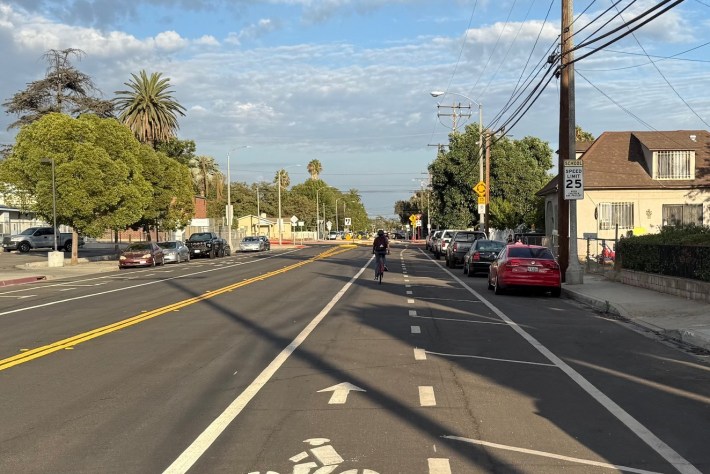
Pomona is still wrapping up construction, and the new roundabouts already have their critics. One Facebook commenter termed them "concrete flying saucers."
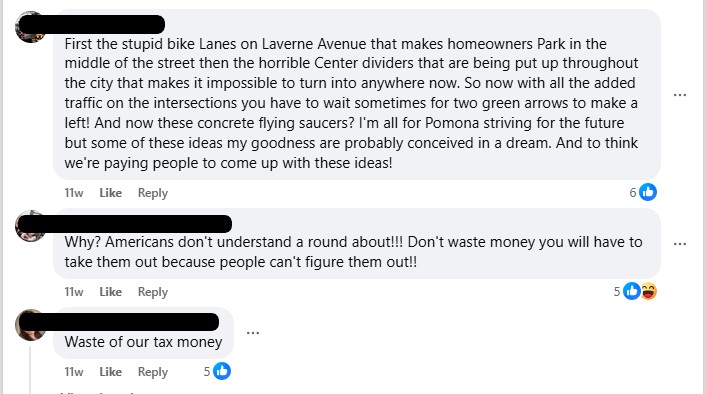
When Streetsblog observed them, over the past couple months, the good news is that fast-moving drivers are indeed slowing down at the new roundabouts.
Garey Avenue Rehabilitation Project
Garey Avenue is Pomona's main north-south drag, connecting City Hall, downtown, and the new Metro station. The city is wrapping up construction on the southern half of its Garey Avenue Rehabilitation Project.

The Garey project includes a lot of new landscaping, and pedestrian/accessibility features. It also includes new bike lanes, some of which necessitated the removal of on-street parking
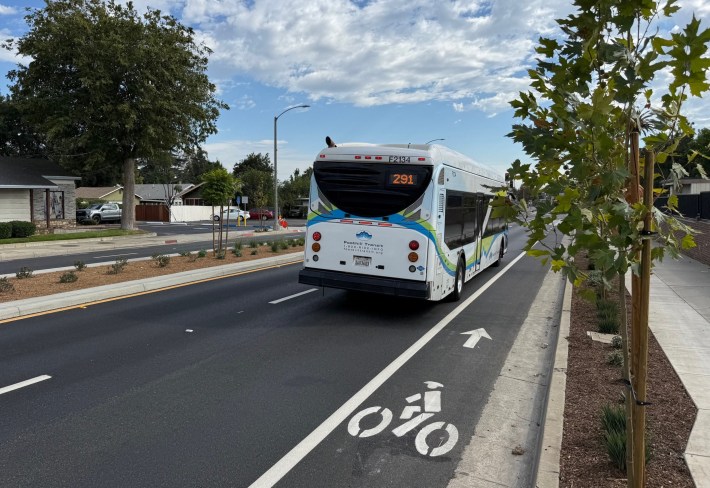
Additional Bikeways
Pomona also has plenty of basic bike lanes. Some are decades old.

Many are more recent, installed as the city expanded its bike network. Several recent bike lanes are buffered, which is slightly better than basic non-buffered, but not as high quality as protected lanes.
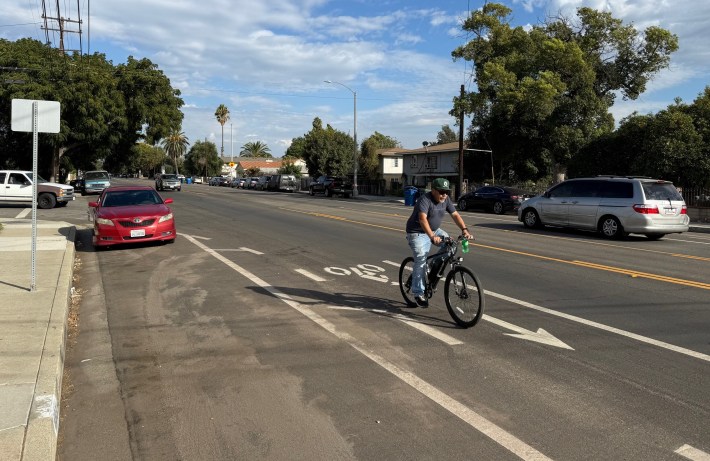
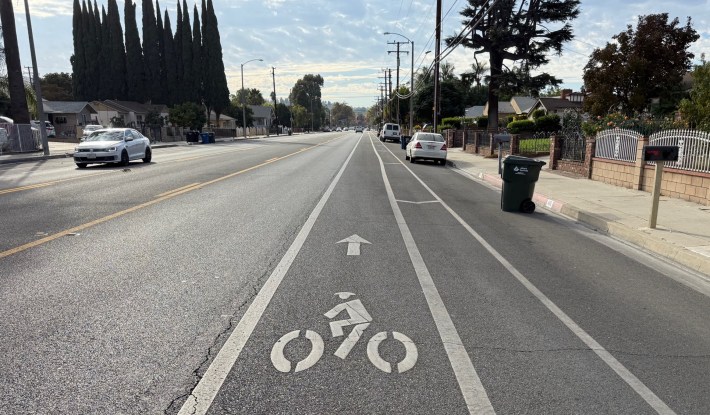
The city has also been installing some sharrows - shared lane markings - known as the dregs of bike infrastructure. Sharrows are never an optimum high quality treatment, but can sometimes help somewhat with directing cyclists onto appropriate low-traffic streets.


Grants and Future Mobility Projects
Pomona has been successful in securing quite a bit of grant funding which got the above improvements installed, as well as supporting future bike/walk/transit facilities coming soon. Most grants are just the city, but some are in partnership with the San Gabriel Valley Council of Governments (SGVCOG), and other adjacent communities.
Recent Pomona safe streets grants include:
- $20 million from the CA Active Transportation Program (ATP), for walk and bike safety improvements - awarded 2024
- $11.3 million from CA ATP, for San Jose Creek path (see below) - awarded 2023
- $9 million from CA ATP, for walk/bike upgrades - awarded 2019
- $1.9 million from Metro for A Line Station first/last mile walk/bike facilities - awarded September 2025
- $400,000 federal earmark from Congressmember Norma Torres, for street safety planning - awarded 2023
- $200,000 from CA Transformative Climate Communities, for planning - awarded 2020. This led to Pomona receiving a portion of a later eight-party TCC $22 million implementation grant.
- Additional grants from Metro, CA Affordable Housing and Sustainable Communities (AHSC), and So. Cal Association of Gov'ts (SCAG) GoHuman.
Below are some future bike/walk/transit plans and projects that Pomona is currently working on:
- The city is finalizing designs for funded safety upgrades on Hamiliton Avenue and Park Avenue [fact sheet], focused on safer rail crossings, also including bike, crosswalk, sidewalk, and accessibility features.
- The city is finalizing plans for its Complete Streets and Quick Build Project [fact sheet], expected to result in a safety installation, evaluation, and new policy - all in 2026.
- The city is completing plans for a new 3.5-mile bike/walk path along San Jose Creek, funded via ATP. See the city's San Jose Creek project website and recent outreach materials.
- The under construction 19-mile West Valley Connector 19-mile bus rapid transit (BRT) project is located mainly in San Bernardino County, and partially in Pomona. Fast frequent bus service will connect between the downtown Pomona Transit Center and Rancho Cucamonga Station, the planned terminus for Brightline high-speed rail to Las Vegas.
- Pomona is looking for a place to build a new bike park - with BMX bike jump loops - which was previously slated for Ganesha Park.
One way to keep up with Pomona plans/projects/programs is to subscribe to the City Manager's weekly email.
Streetsblog’s San Gabriel Valley coverage (which includes the adjacent Pomona Valley) is supported by Foothill Transit, offering car-free travel throughout the San Gabriel Valley with connections to the A Line Stations across the Foothills and Commuter Express lines traveling into the heart of downtown L.A. To plan your trip, visit Foothill Transit. “Foothill Transit. Going Good Places.” Sign-up for our SGV Connect Newsletter, coming to your inbox on Fridays!




